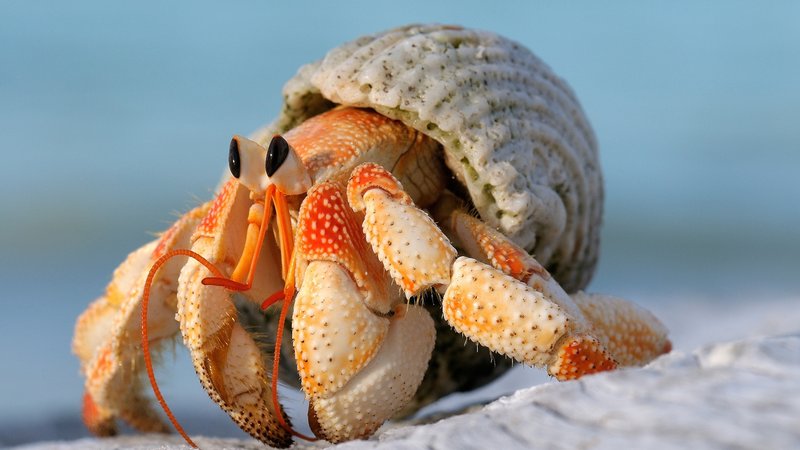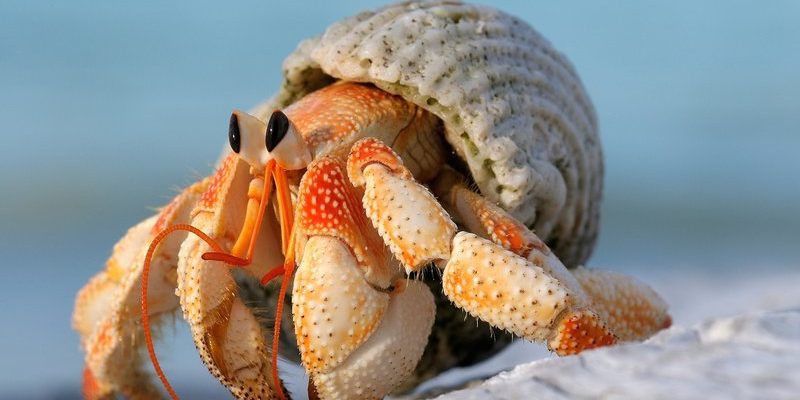
These little guys are not just beach dwellers; they’re adaptable creatures that can teach us a lot about survival and resilience. Right from the shell they choose to their social interactions, hermit crabs have some cool tricks up their sleeves (or shells, rather). Let’s uncover ten amazing facts about hermit crabs that will make you appreciate them even more.
1. Hermit Crabs Aren’t True Crabs
You might be surprised to learn that hermit crabs aren’t actually crabs at all! While they belong to the same class called Malacostraca, they’re more closely related to lobsters. Isn’t that wild? Unlike true crabs, hermit crabs have soft abdomens that they protect by residing in the shells of other animals. So, while they look a bit like crabs, their anatomy tells a different story.
Most people mistakenly think all “crabs” have hard shells. Instead, hermit crabs are like the clever renters of the sea. They often swap shells as they grow, making their homes quite the evolving collection. Imagine moving from a cozy studio to a spacious three-bedroom house; that’s what these little guys do as they grow!
2. They Have Preference for Shells
When it comes to choosing a shell, hermit crabs are picky! They prefer shells that fit just right—not too big or too small. Think about trying on shoes; you wouldn’t want to wear a size too big, right? A snug fit is crucial for their protection, especially from predators.
You might find it interesting that hermit crabs can be quite particular about the shell’s texture and shape, too. Some may opt for spiral shells, while others might prefer more oval-shaped homes. It’s a bit like choosing between a cozy cottage and a modern apartment. Each shell provides different vibes and advantages, all so they can feel safe and secure.
3. They’re Social Creatures
Hermit crabs might seem solitary, but they love the company of their fellow crabs. They often form little communities, engaging in all sorts of social behaviors. It’s like a mini neighborhood where they can “hang out” together!
When they come across a new shell, they might engage in a sort of social ritual. Imagine a group of friends discussing who gets to wear the new jacket. Hermit crabs will often compete for shells, with the winner taking the prize and the losers moving on to find something else. This social dynamic is essential for their survival and adds a layer of complexity to their daily lives.
4. They’re Great Escape Artists
If you ever have a hermit crab as a pet, be prepared for their Houdini-like talents! Hermit crabs are known for their ability to escape enclosures. Think of them as little adventurers, always looking for a way to explore the world beyond their tank.
One reason they’re such great escape artists is their ability to flatten their bodies. When they want to squeeze through tight spots, their soft bodies can manipulate their shape. To keep your pet hermit crab safe, it’s a good idea to have a lid on their enclosure and to check it regularly for any potential escape routes.
5. They Need Moisture to Breathe
Here’s a fascinating fact: hermit crabs *breathe through gills*. Unlike most crabs, which live fully in water, hermit crabs can survive on land, but they need to keep their gills moist. It’s like needing a drink of water just to breathe!
This moisture requirement means that you might see hermit crabs soaking in shallow water or moving to damp areas. To help them thrive in captivity, ensure their environment is humid enough. A simple spray of water can go a long way in making them comfortable and happy.
6. They Can Live A Long Time
You might think hermit crabs are just temporary pets, but they can actually live for 10 years or more! That’s a surprisingly long lifespan for such small creatures. Think about it: if you adopt one, you could have a little companion for a decade!
In the wild, some hermit crabs have been known to live even longer—up to 30 years. Their longevity depends on factors like habitat, diet, and protection from predators. So, when thinking about adopting a hermit crab, remember that you’re making a long-term commitment!
7. They’re Omnivores
Hermit crabs have a diverse diet since they’re omnivores. This means they eat both plants and animals. In the wild, they munch on seaweed, fruits, and even tiny insects. It’s like having a buffet at their disposal!
If you’re thinking about feeding a hermit crab, you can mix up their meals with a variety of foods. Things like fresh fruits, vegetables, and specially formulated hermit crab food are ideal. Just avoid overfeeding, as a balance is key to keeping them healthy and happy.
8. They Communicate with Each Other
Hermit crabs may not have a complex language like humans, but they communicate through a series of gestures and signals. They often wave their claws or make specific movements to express feelings or intentions. Imagine waving hello to a friend; it’s their way of saying, “Hey, I’m here!”
These interactions can help them establish social order within their community. Observing these behaviors can be quite entertaining as you witness hermit crabs ‘talking’ to one another without saying a word!
9. They Can Regenerate Lost Limbs
If a hermit crab loses a leg, there’s no need to worry—they can regenerate it! This remarkable ability is one of nature’s wonders. Over time, the limb will grow back, similar to how some lizards can regrow their tails.
This regeneration process can take a while, so patience is essential. The new limb might come back smaller or differently shaped at first, but eventually, it will resemble the original. It’s just one more way these little creatures show their resilience!
10. They Are at Risk Due to Habitat Loss
Unfortunately, hermit crabs face challenges in the wild, mainly due to habitat loss. Their coastal homes are often threatened by pollution, climate change, and human activity. This loss impacts their food sources and safe places to live.
Being aware of this issue is important. If you ever consider adopting a hermit crab, look for reputable sources and avoid taking them from the wild. Protecting their habitats means we can enjoy these unique creatures for years to come.
As we wrap up our journey into the world of hermit crabs, it’s clear there’s so much more to them than meets the eye. From their quirky choices in shells to their impressive longevity and social behaviors, hermit crabs are fascinating little creatures. Whether you’re considering getting one as a pet or just curious about them, we hope you’ve found some cool new insights that’ll make you appreciate these tiny adventurers even more!

